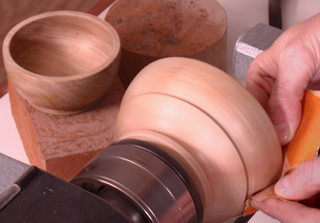
I have read Betty Scarpino’s article on Lathe Sanding Secrets and would like clarification on one part of it. When hand sanding a bowl, she recommends sanding at a slow speed. Can you be a bit more specific, please? 300 – 500 – 800 ? After turning a project at 1,800 rpm or better, everything to me seems slow. Appreciate your help and keep up the great work! – Gary Kostick
Tim Inman: Well, this might give everybody a headache, but let me just say two things about speed and sanding: One, sanding speed is a very personal preference based upon the operator (you), the wood type, the size and shapes of the object in question, and the results you’re after.
Two, rpm gets all the press, but it is actually fpm that is more important. Here’s the headache part, because math gets involved. R stands for revolutions. This is easy to measure and understand: how many times per minute does the object spin around? The answer is the same for a thimble as it is for a big punch bowl. Easy to count. But the really important issue is F, which stands for feet per minute. This varies depending upon the diameter of the object being turned. In other words, how many “feet” of wood surface actually show up to be sanded in one minute? If the object is a thimble, with a diameter of .5 inches, then the fpm would be something like 65 fpm at 500 rpm. On the other hand, if you’re turning a punch bowl with a diameter of 18 inches, then the fpm would be about 2,355 feet at 500 rpm: over 35 times as much sanding surface in the same time spinning on the lathe. Considered another way, the thimble represents running a piece of sandpaper the length of your shop and back in one minute. The bowl means you need to run that same sandpaper almost half a mile in one minute!
Fpm is important to understand because not only is there more surface to sand on big projects, the faster that surface passes under the sandpaper, the hotter that sandpaper gets – and heat is ultimately what kills sandpaper and spoils good surface prep. Use the slowest speed that does the job the way you like it; that’s my rule.
Chris Marshall: To complement Tim’s sanding strategy, I’d also suggest trying to refine your bowl turnings as far as possible with sharp tools before commencing with the sanding stage. The more of that end grain you can shear away cleanly with a gouge or scraper, the less aggressively you’ll have to sand it to blend it in with the long grain areas. Then sanding at whatever speed won’t be such a chore.





